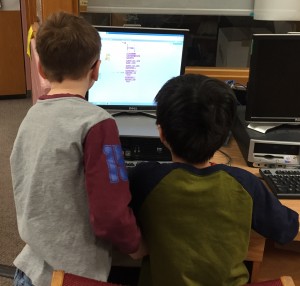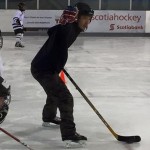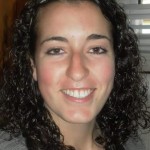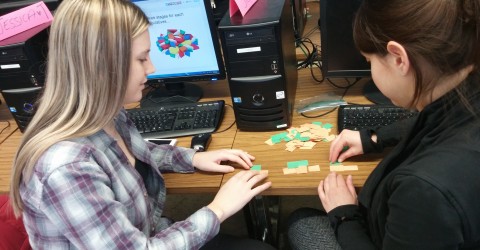
The Faculty of Education at Western University in London, Ontario offers two brand new Computational Thinking courses- one math course for all Primary/Junior teacher candidates and one for Intermediate/Senior teacher candidates who have math and science teachables or have opted for the STEM cohort. The candidates have the opportunity to explore the role of computer coding and digital making as a means to teach math and science concepts to children. Scratch and Python programming, programmable robots (Spheros), microcontrollers (Arduinos), and electronic stickers (chibitronics), as well as unplugged activities are all used to demonstrate how Computational Thinking can enhance the understanding of science and math ideas.
As part of a culminating activity, some teacher candidates elected to teach a Computational Thinking task to primary/junior/intermediate students at local elementary schools. Teachers and principals were very supportive in welcoming the candidates into their schools, recognizing the potential benefits of integrating Computational Thinking into existing curriculum.
Below, are reflections and descriptions of activities that some teacher candidates tried with students. It is clear that the students, teacher candidates and observing teachers appreciated the experience. The current instructor of the courses, Lisa Floyd loves hearing about the rich learning experience enjoyed by all who were involved with the activities.
Unplugged Activity – Coding a Student to Reach Kelso, the Frog
By: Britney Bailey
Integrating coding into existing curriculum is helping to connect schools with their 21st century learners. However, most educators are not yet proficient at coding and this new journey can be a very frightening one. This raises a question:
How do we bridge the gap between integrating coding in the classroom and the novice coder?
The foundation of the bridge can be incorporating unplugged activity into lessons, such as the one I presented to a SK/Gr. 1 class, a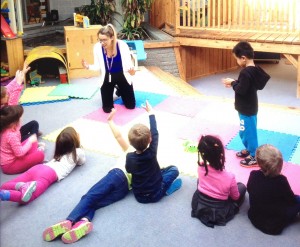 s described here.
s described here.
Using 24 connected foam floor tiles, one student stood on one of the tiles, while Kelso, the stuffed frog was placed on another foam tile. The class’s mission was to code the student to move from one foam floor tile to the next only using the phrases, up, down, left, right to get to Kelso. Once the students got the hang of the activity, I made the activity more challenging by removing some of the tiles and informing the class that the student who was being coded could only get to Kelso via the foam tiles.
This activity is focused on introducing the students to Computational Thinking and more specifically, algorithms. The students were decomposing the problem into procedural steps and then providing a step-by-step set of instructions to be executed by the “programmed student” to solve the problem. Through my observation, I was able to see that the students were productively engaged in the activity and each student was actively participating. This activity was helping to create opportunities for the students to take ownership of their learning experiences and promote collaboration and peer learning. A suggested alteration depending on your students and grade level, would be to model the activity before having the student begin. The feedback I received from the students was that this activity stimulated their interest and they enthusiastically requested the opportunity to try the activity again.
Britney is a Bachelor of Education Primary/Junior teacher candidate with a concentration in Advanced Studies in the Psychology of Achievement, Inclusion & Mental Health at Western University. She spends her summer working as a camp counselor at an overnight camp, is an enthusiastic world traveler, and is passionate about bringing out the best in everyone.
Engage!
By: Brian Yam
I spent most of my youth watching Captain Jean – Luc Picard in the Star Trek: Next Generation television series. What attracted me to this show was the fact that here were a bunch of people in a ship looking for something new they had never seen or learned before. Simple concept? Sure, but that is what made the Star Trek aura so fascinating to a kid living in downtown Toronto.
Now, beaming to a Grade 3 class at Parkview Public School in Markham, here I was standing in front of a class of 21 students where I planned to teach for the first time, a lesson about computational thinking in mathematics. It was the first time for everyone in the room ever seeing something like this. Here I was, a former investment banker/corporate career lifer who made the leap to become a primary/junior teacher. I definitely was on a different star ship now, about to teach a subject I didn’t even know existed a few months earlier.
Was I nervous? No, not in the traditional sense, I had done many business presentations before in my previous career. But I was nervous. Because guess who was in this class? My own son. And just like Captain Picard, they were looking to me eagerly, to show them something they had never seen before. It was time to point the finger toward the stars and say “engage!” That is how I felt standing in front of the class.
I started the lesson with an explanation of why I was here, and the purpose of the lesson. I wanted to know what they thought about coding. I then began framing questions, such as “What is computer programming?” and “Where do you see it around us?” I found that the example of the heating system in the school being controlled by a computer made a strong connection to the students about how important computer programming is to our lives.
I then followed with a video from YouTube of the character Wall-E making a square from garbage as my hook. Before playing the video, I threw out the framing question, “Think why the robot knows what to do?” Once the video was finished I asked, “What shape was Wall–E making”? And “Why does Wall-E know how to make a square, not a triangle or a circle?” Very quickly the students connected to this line of thought and eager hands went up. Their teacher smiled. I wished at that moment I could pick them all to answer, but I had to choose one. I picked a student named Evan, and he smiled and said “programming!” Yes Captain Picard we are at warp 9 now!
I felt the class momentum started to really pick up from that point. I followed the video with a teacher modelling exercise where I would pretend I was Wall-E and the class were programmers telling me how to walk in a square. They laughed at the initial disorganization caused by their instructions, but quickly tightened their instructions to make sure I walked in a square. They were using terms such as 90 degrees and right angles. We had found gold! The class was starting to think like programmers and mathematicians at the same time.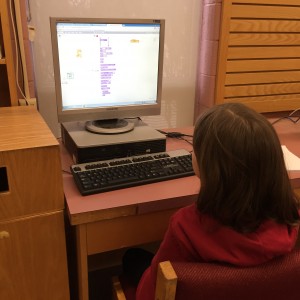
The next part of the lesson was getting on the computers and using the program Scratch together. I was amazed how quickly the students engaged the Scratch program. Frankly, most students were far ahead of many university students (myself included) at this same stage.
One interesting aspect I noticed was the level of attention by the boys. This was known to be a class that had a lot of energy (most of the students are boys), yet they were generally well-behaved as they were keen to go through the lesson. The programming almost had a calming effect.
We then moved to the really fun part,- the Spheros! I had access to three units from the Faculty of Education as well as my own Star Wars BB8 version. The students loved the Sphero/BB8 and appreciated the opportunity to stretch their imagination and move around physically. Connection to multiple Spheros was a little challenging, so this caused a bit of unneeded frustration for the students as they all wanted their turn. But, in the development of a growth mindset, encountering road blocks is a good thing. And just like the star ship Enterprise, you have to keep going even if you lose the engines and sensors!
We closed the lesson with some stars and wishes of the lesson. I tried my best to get some wishes, but there were none. The students then wrote a reflection of the lesson.
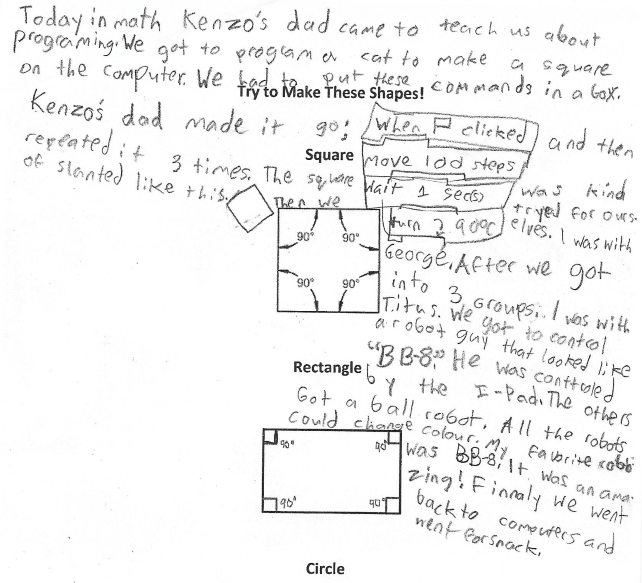 How did I know that the students had a great lesson? When the buzzer went to signal their recess, they all asked if they could skip recess and keep on going. Some asked if the Scratch program is free, others wanted me to write down the Sphero name so they could get their parents to buy them one. You know you made an impact when kids are willing to skip their morning recess! I bumped into a parent the next day and all she could talk about was how her daughter saved the Scratch file she was working on in class and could not stop working on it at home.
How did I know that the students had a great lesson? When the buzzer went to signal their recess, they all asked if they could skip recess and keep on going. Some asked if the Scratch program is free, others wanted me to write down the Sphero name so they could get their parents to buy them one. You know you made an impact when kids are willing to skip their morning recess! I bumped into a parent the next day and all she could talk about was how her daughter saved the Scratch file she was working on in class and could not stop working on it at home.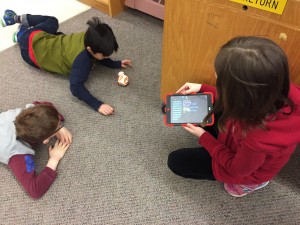
What did I learn from the lesson? In just one hour, the students’ inquiry growth mindset capacity was developing before me. Their universe had expanded. I think the power of using computational math is that it melds the discipline of understanding math in a pragmatic manner, but in a way where the learning is almost seamless and enjoyable. The students are provided with a high ceiling in terms of where they want to take the lesson. In a way, it enables the educator to employ differentiated instruction naturally, as programming allows students to interact with it at their own ability and style. It is almost like an elastic band, expanding and contracting based on the needs of the situation.
For me personally, it was a great experience to teach a class something they have never seen before, and I do believe it is a lesson that will linger in their minds…perhaps I even helped to light a spark to encourage them to explore coding further.
*Brian wishes to thank Principal Lisa Dilworth, Vice – Principal Penny Lam, Teacher Alison Chong and the rest of the staff at Parkview Public School for their support to make this lesson possible.
Brian is a primary junior teacher candidate at Western University. Previously, he spent 15 years working in the corporate world, and fell in love with teaching unexpectedly while volunteering at his children’s school. He is passionate about inquiry based teaching, engaging in authentic learning experiences and making strong connections to students. Follow him on Twitter @brianyam
Coding Shapes in Scratch with Grades 3/4
By: Samantha Lynch
The students really enjoy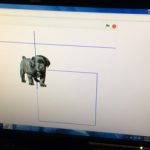 ed this activity, which involved coding sprites to move as well as completing other actions. Some of the students were confused when they were asked to direct me how to walk a square, which was the hook at the beginning of our lesson. When they told me to walk forward, I just kept walking, or when they told me to go down, I squatted down. They quickly caught on that they needed to be very specific with their “code” so that I would know exactly what they wanted me to do. Two boys in particular were very engaged in making our own code together for a square and recognized that we needed four sides. To begin, I started to code each side individually to reiterate that point when a boy stopped me and said, “Can’t we just repeat that process for each side since they are all the same length?” This was a great feeling because I knew that they were understanding the concept and what we were trying to do. Many students were out of their seats showing their classmates what they had done and how they did it. It was exciting to see the inquiry and engagement on the students’ faces with making new programs and figuring out how to do what the others were doing.
ed this activity, which involved coding sprites to move as well as completing other actions. Some of the students were confused when they were asked to direct me how to walk a square, which was the hook at the beginning of our lesson. When they told me to walk forward, I just kept walking, or when they told me to go down, I squatted down. They quickly caught on that they needed to be very specific with their “code” so that I would know exactly what they wanted me to do. Two boys in particular were very engaged in making our own code together for a square and recognized that we needed four sides. To begin, I started to code each side individually to reiterate that point when a boy stopped me and said, “Can’t we just repeat that process for each side since they are all the same length?” This was a great feeling because I knew that they were understanding the concept and what we were trying to do. Many students were out of their seats showing their classmates what they had done and how they did it. It was exciting to see the inquiry and engagement on the students’ faces with making new programs and figuring out how to do what the others were doing.
Samantha is a first year teacher candidate at Western University Bachelor of Education and hopes to become a primary/junior teacher in Ontario. She is excited to continue working with students and to see the joy in their eyes as they learn and grow.
Cheryl, Alex and Katherine taught a lesson to a grade 4/5 class together. Their individual reflections can be found below:
Teachers: To Teach, We Must Continue to Learn
By: Cheryl Madliger
As part of the new two-year format of teachers’ college in Ontario, current teacher candidates not only specialize in their teachable subjects, but also add a cohort specialty to their list of qualifications. As part of the STEM specialty, I have frequently been told that I am gaining knowledge in an area that is becoming increasingly important in today’s schools. As part of a visit to a Grade 4/5 classroom, along with two of my fellow teacher candidates, we used Scratch (scratch.mit.edu) to incorporate coding into a Math lesson. I saw my newfound skill-set in use and realized that as graduating young teachers, we will bring valuable skills to classrooms that other teachers might not have had the opportunity to learn yet. My classmates and I felt as though we could have taught the class so many other concepts through coding and had hoped to get through a lot more, including the incorporation of the use of the Sphero, a robotic toy that can be programmed using block-based coding similar to that used in Scratch. The classroom teacher thanked us for coming in and even invited us back to do more work with the students! At one point, he commented on how we were bringing something to the kids that he otherwise wouldn’t have been able to.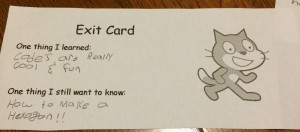
Being a part of the STEM cohort has stretched me as an educator. I spent the last seven years of my life in Kinesiology programs and while I can say that there is a Masters degree on my wall, I cannot say that I’ve ever learned a thing to do with coding or computational thinking before enrolling in teachers’ college. What has come from my experiences, is we ought to embrace these opportunities to develop our skills to match the needs of today’s students. Ten years ago, when I was in high school, we lived in a different world—there were no smartphones or tablets in students’ hands, I had never seen a SmartBoard, and I certainly didn’t think I would be learning computer programming any time in my future. The rate of change thanks to technology is rapid, and seems to show no signs of slowing down. Although it can be difficult to keep up, I’ve learned that it is so important to work together as teachers—as we did, by bringing our lesson to that Grade 4/5 classroom and sharing our ideas with a teacher who will be able to use it in his own lesson plans in the future—so that the needs of the students are kept at the forefront of our teaching.
Cheryl is currently working on her BEd at Althouse. She is in the I/S General Science and Biology teachables, but is learning that to be a teacher is about a lot more than subject specialties.
Why should you introduce coding into your math class? Because the kids love it!
By: Alexandria Procenko
In my opinion, as a teacher candidate learning how to teach, as well as in my experience as a student, making Math exciting seems a near impossible feat. Tell students that they get to go to the computer lab to do some coding for today’s math class however, and all of a sudden they can barely stay in their seats.
I recently went to a school to teach a grade 4/5 split class an introductory computer coding lesson masquerading in a Math lesson, along with two of my fellow teacher candidates. The plan was to use Scratch, which is a block-based coding language developed by MIT (scratch.mit.edu), to teach the kids both the basics of computer coding and to give them an opportunity to look at geometry through a new perspective. I was terrified. I was not scared of the kids, or scared of the Math, but I myself had only just learned how to draw a square in Scratch the month before. How was I supposed to teach this when I myself am still learning it?
What I want to tell you is that even if you are new to computer coding yourself, take the risk and introduce it to your students. We have all heard that computer coding is a skill that all students should learn, but I think the best reason why you should bring coding in to your classroom is because the kids love it. Figuring out how to make an animated “Sprite” do something is so much more fun than completing a worksheet. Using Scratch got the kids thinking about math in a new way, even if they didn’t realize it. Every single student was engaged in the activity. Even if they were stuck, they were still engaged. Those students who were able to draw a square before everybody else were able to move onto other shapes. Seeing their progress and what could be made, the students wanted to do more.
In my own short journey in learning how to code, I have consistently recognized I am learning how to learn again. To learn to code, you have to overcome the fear of not knowing how to do something. Using Scratch enables you to learn to code in a non-threatening way. There isn’t a wrong answer; there is just the satisfaction of getting your Sprite to finally do what you want it to do. Using Scratch is more akin to playing a game than learning something new. So even if you figured out how to make a square the night before you are going to teach your students how to, just think of their faces when you tell them that you get to program Sprites in Math class today.
Alex is a first-year teacher candidate at Western. Her teachable subjects are I/S General Science and Biology. Although her father is a computer programmer, this is her first year learning to code.
Computational Thinking in the Math Classroom
By: Katherine Kornobis
In the context of a math classroom, computational thinking may be applied as another tool to help students learn. I will use the example of our recent visit to a grade 4/5 classroom to teach coding using Scratch. Recently, in Math class, the students have been learning about shapes and the difference between acute, obtuse and right angles. We could have gone in and taught the students angles and shapes using the chalkboard and worksheets, but instead we took a more interactive approach by using Scratch (scratch.mit.edu). The kids were given a handout with instructions on how to make their sprite draw a line, and then they had to figure out how to draw a square. This was a different approach to the problem and it helps students to think in a more systematic way. The advantage to using Scratch is that it is a block-based coding language, so it’s easy for kids to grasp and figure out, and there are seemingly endless applications and curriculum links. Using Scratch to solve problems is a nice way of integrating different components of STEM together, which is something that very few of us had when we were in elementary school ourselves.
Katherine is in her first year of teachers’ college at Western in I/S Biology/Chemistry. While she has found learning to code somewhat intimidating, she is excited to learn alongside her future students.
Course Descriptions:
Computational Thinking in Mathematics Education (P/J) – A critical introduction to the role of computer coding and digital making as ways of teaching mathematics concepts and relationships to children. The history, current trends, future possibilities of computational thinking in elementary school mathematics education are situated within the broader context of mathematics, science, and technology education.
Computational Thinking in Mathematics and Science Education (I/S) – A critical introduction to the role of computer coding and digital making as ways of teaching mathematics and science concepts and relationships. The history, current trends, and future possibilities of computational thinking in mathematics and science education are situated with the broader context of mathematics, science, and technology education.

